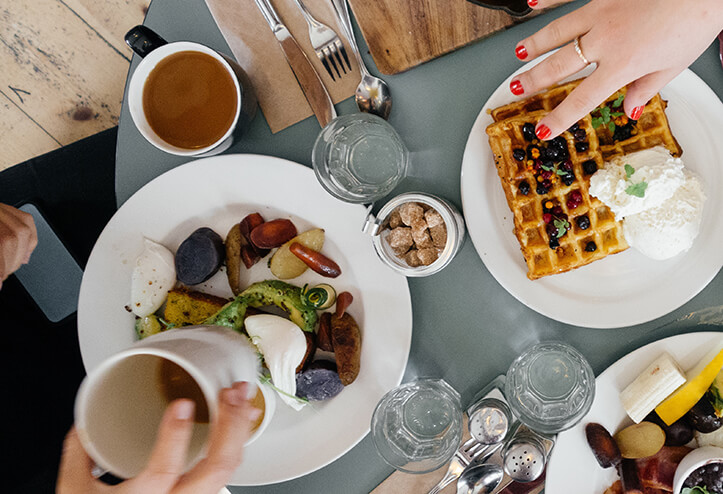With the Christmas party season fast approaching, chances are you’re going to be eating out more often than normal. Whether it’s a party with work colleagues, a night out with family and friends or a house party with the neighbours, the festive season can play havoc with any sort of healthy eating plan.
When you’re watching your nutrition as part of customised exercise plan, eating out can throw any number of spanners into your perfectly organised work. Planning your own meals at home helps you to monitor your macros, your calorie intake, your portion size and the quality of ingredients you use. Eating at a restaurant, or even at someone else’s home, takes all of those controls out of your hands.

The thing is, your nutritional plan shouldn’t be so restrictive that you need to shy away from going to a party, but you should be able to incorporate your own dietary needs so it continues to work to your advantage. How do you do that? Let’s take a look.
A restaurant menu is a literal feast of amazing food, many of which sound perfectly delicious, but will contain an abundance of all those things you’ve been trying to keep a close eye on. Whether it’s fats, carbs, protein or oil, you have little or no control over how much (or how little) your food will contain. More and more restaurants are starting to publish nutritional information on their menu, which is a good start, but it’s less common than it should be, which makes it hard to calculate to any real degree.
The fact is, you’re not going to be able to accurately establish the nutritional data that you need down to the last calorie. It’s just not possible. The thing is, unless you’re in the final stages of training for an elite event, it doesn’t really matter that much. All we can hope for is a ‘best guess’ which will get better the more you learn about the food you eat. Also, I wouldn’t turn to apps that claim to offer this information. The fact is ‘chicken’ will vary in size, weight and how it’s cooked, so any apps that claim exact nutritional information is misleading. Similarly with things like ‘garden salad’. There isn’t a standard size or list of ingredients for those so again, those apps should be discarded.
It’s important to look at portion size first. Don’t worry too much about getting it spot-on, you’re always going to be off a little bit. Restaurant portion sizes vary as much as people. From the ‘Man vs Food’-style enormo-plates to the smaller, nouvelle-cuisine elegance. The key is knowing what’s in your food.
It’s all too easy to forget about things like cheese in sauces or crumbled in salads when looking at portion size. High fat cheese in the smallest of meals can throw your best intentions out the window. When it comes to meat, again it’s hard to be exact, but the macros for things like steak can vary enormously depending on the type of cut you’re having, but most restaurant will list the weight. For example, sirloin steak is around 282 calories per 4oz serving, rib-eye is around 437 calories and rump is around 200. Again, if you have a sauce with that, you’ll need to give it your best guess. Don’t forget to add some grams for the fat (i.e. butter) it will be cooked in.
If you’re a vegetarian (or vegan), then try and estimate the proteins, carbs and fats in the individual food components. For vegetarian diets, I would set protein lower and carbs and fats higher than ‘normal’. You can begin to see why it’s difficult to monitor your macros when dining out. It’s all too easy to forget about the nuts, dressing, oil, butter, cheese and bread that often accompany your meal.
So what can you order that will keep you in line with your goals. Obviously I don’t know what your individual goals are, but let’s assume you’re wanting to lose weight and / or gain muscle through a high-protein diet. With that in mind, I would recommend some ‘safe’ options like grilled chicken, pork loin, game or shellfish like crab or lobster. If these can be combined with a salad, then even better. I would always try and go for meals that have fewer components, i.e. meat, vegetables and carb-heavy food like potatoes or rice. Any more than that and even guessing your macros becomes difficult.
You can also utilise some tried-and-tested routines when it comes to eating out. You could try the ‘Pick Two’ rule, which means you can order two courses (rather than three) which should probably be the starter and main. You could also try intermittent fasting and plan your day around the meal you’re going to have later in the evening.
If you’re worried about letting all your good work go to waste over the Christmas period then I would say that you shouldn’t. Your success isn’t measured by one (or even two or three) nights out with your friends. Of course you shouldn’t just throw caution to the wind and gorge yourself either, but even if you did, it doesn’t mean failure. Your progress isn’t measured over the course of one meal in one night, it’s measured over a week or a month. If you do over-indulge, then just go harder in the gym the next day. It’s Christmas. Enjoy yourself.










